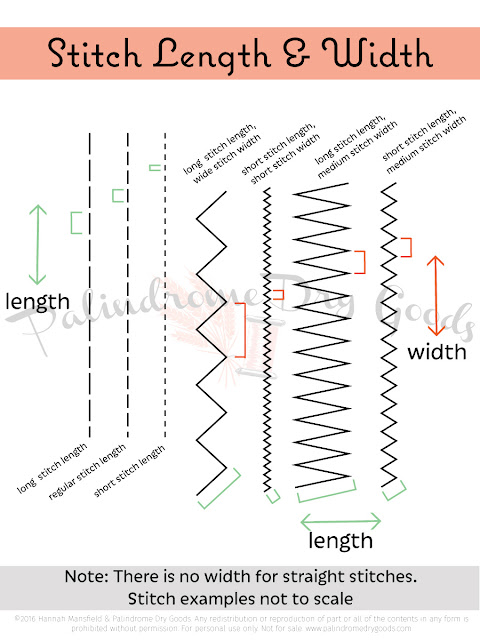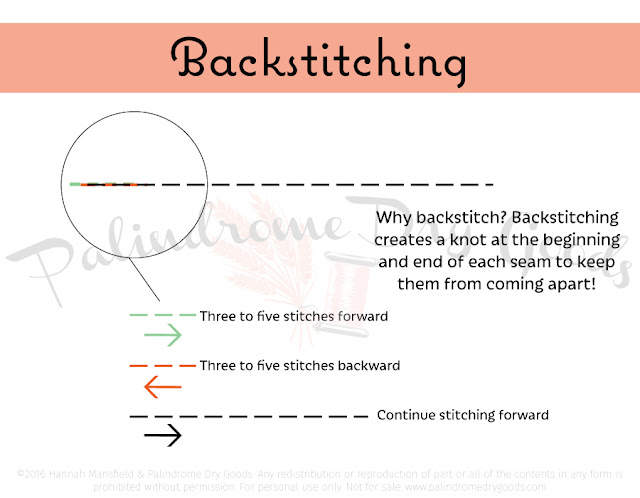Hello everyone! If you're on the East Coast, I hope you're faring this storm ok. We're supposed to get a couple feet here in Charleston, it's a great time to cozy up inside and bring you all a new Sewcabulary lesson! Today we'll be talking about seams and stitches. They're the foundation of our sewing, and therefore, deserve a good, thorough, lesson.
Read on for a FREE printable guide to seam length & width, and a whole bunch of valuable sewing knowledge!
What's the Difference Between a Seam and a Stitch?
Great question! A seam is comprised of many stitches. When your sewing machine needle passes down through the fabric, and then back up, and then back down, it creates one stitch. These consecutive stitches make up a seam.
Stitch Length & Width
There's a lot to talk about when it comes to lenghth and width, and while it may seem confusing at first, I promise it gets easier to understand the more you experiment with your sewing machine. Do you have your sewing machine manual? Great, open it up and look for stitch length & width in the index. Your manual should have some diagrams to help you understand how to set these (usually with a dial, or sliding bar, or, for new machines, by pressing a button).
Stitch length is the length of our individual stitches. A long stitch is called a basting stitch and is essential for sewists because they're easy to remove. Basted seams are large used for test-runs. We use basting stitches to:
- temporarily hold a sleeve in place so we can try it on to make sure it fits
- temporarily hem a skirt or dress to make sure we like the length
- temporarily hold a zipper in place to make sure it isn't crooked
- and a LOT more
After we've used a basting seam and we know that our sleeve/skirt/etc is correct, we can then sew over it again with a regular length seam and pick out our old basting seam.
Your sewing machine manual should tell you which number represents your stitch length. TYPICALLY (but NOT always), a long stitch is represented by a low number (2, 4, 6) and a short stitch length is represented by a high number (10, 12, 14).
On my sewing machine (below), the bottom knob changes by stitch length. My long, basting, stitch is set by turning the dial to 4, and my shortest stitch length is set by turning the dial to 1. The regular stitch length (that I use for most sewing) is set by turning the dial between 2 and 3.
Stitch width is the distance that our sewing machine needle moves between the peaks of our zig-zag, embroidery, or overlock stitches. Stitch width does NOT apply to straight stitches. Why? Because straight stitches are, well, straight, and because the needle does not move side to side to make them (it only moves forwards), they cannot possibly have a width. They are only as wide as our thread. Does that make sense? If not, please comment below and ask for more clarification!
Now whether you have a manual or not, I've made a nifty little print-out for you to use and keep!
Click the link below to download!
There are hundreds of stitch width + length combinations for zig zag, embroidery and overlock stitches. The best way to learn them? Sit down at your sewing machine and make yourself a sampler. Start with a small stitch width and a small stitch length. Sew a seam. Write down the numbers for the seam width + length right next to the seam.
Move onto a small stitch width and a slightly larger stitch length. Sew a seam. Write down the numbers for the seam width + length right next to the seam.
Move onto a small stitch width and a large stitch length. Sew a seam. Write down the numbers for the seam width + length right next to the seam.
Try it the other way around. Long stitch width + small stitch length. Long stitch width + regular stitch length. Long stitch width + long stitch length. Regular stitch length + short stitch width. Regular stitch length + regular stitch width. Regular stitch length + long stitch width.
Etcetera, etcetera, etcetera. Then you'll have an awesome piece of fabric with a bajillion combinations to reference when you're not sure what setting to use!
Staystitching is when we sew a simple seam around a curved edge to keep it from stretching. Sewing this seam (within the seam allowance) on curved edges, such as a neckline or armhole, makes it much easier to match it up to it's coordinating pieces later on. Below are examples of two separate patterns that call for stay-stitching.

Staystitching is when we sew a simple seam around a curved edge to keep it from stretching. Sewing this seam (within the seam allowance) on curved edges, such as a neckline or armhole, makes it much easier to match it up to it's coordinating pieces later on. Below are examples of two separate patterns that call for stay-stitching.

Backstitching is when we create a knot at the beginning and end of each seam. This prevents our seams from unravelling and is something you should do on every single seam, unless it's a basting seam, because you'll take that out. Remember? :)
To start a seam: Make 3-5 stitches FORWARD. Then make 3-5 stiches BACKWARD. Then continue stitching forward.
To end a seam: Make 3-5 stitches BACKWARD (over your original seam). Then make 3-5 stitches FORWARD (over your original seam + the stitches you just made in reverse). Trim off your threads and you're done! Now your seams will stay put.
Are you overwhelmed? It's ok! Take a deep breath. This stuff is fundamental, sure, but it's something that becomes easier and easier to understand as you practice.
Have questions? I hope so! Comment below and let me know what you need help with. I am happy to be your personal sewing coach. You got this.














For stay stitching, do you sew inside the seam allowance or on it? Keep up the good work! 💜 Monica
ReplyDeleteHello Monica,
DeleteGreat question. Stay stitching should be done just a hair (1/8 to 1/4 inch) inside your seam allowance. This way it's easy to find and pick out later, if you need to. Thanks for the encouragement and happy sewing!
-Hannah
I have to get used to backstitching. I am used to just stitch forward and create a knot. When you backstitch, does it mean you do not have to create a knot? So it stays put no mater what? Thank you.
ReplyDeleteAna,
DeleteExactly, backstitching makes all your seams stay put! When you backstitch, the machine sews over the same row of stitching enough times that it creates a knot all on it's own. I hope that answers your questions. Thanks for reading!
-Hannah
Hi Hannah, I bought a selection of presser feet for my Janome MC 3500. The feet are named but there are no directions on what they do or how to set them up. Do you have a guide or tutorial that could help me?
ReplyDelete